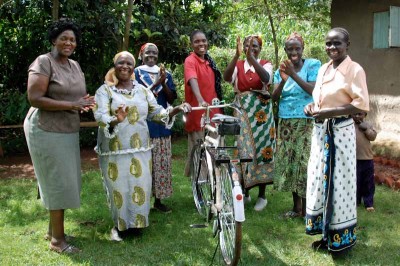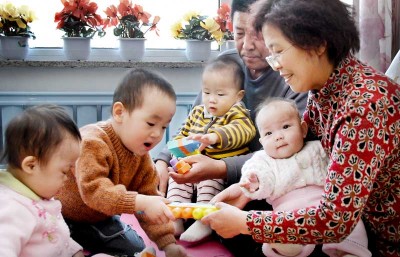Many Seattleites are inspired to do good overseas. But making a real impact means recognizing your limitations and identifying potential partners whose work you can support.
The Puget Sound region has become a hotbed of the “Do-It-Yourself Foreign-Aid Revolution,” a phrase coined by Nicholas Kristof to describe the groundswell of individuals who want to be directly involved in international issues, often by launching their own foreign programs.
Global Washington, a Seattle-based organization that supports Washington-based NGOs (and a Seattle Globalist sponsor), has experienced tremendous growth in its membership over 5 years since its formation.
Getting involved with a foreign cause can take a variety of forms:
For some, this may be raising funds for an intermediary organization that supports foreign projects.
For others, it may mean funding foreign programs and collaborating with the NGOs that operate them.
Or for those who have a burning desire to pursue a passion, and the ability to devote the necessary resources, this can be starting and operating a new program in a foreign country, or even multiple countries.
Each individual and organization will find the path that is right…if they know what it takes to succeed.
Here are three examples of organizations that chose different points along the spectrum of international activities, each with great success:
Families with Children from China (FCC)
Families with Children from China, Inc., of Greater New York (FCC), was formed by a group of American families who had adopted children from China and wanted to create educational and cultural programs for adopted children and their families. In 1996, FCC began to explore various options for providing support to help improve the lives of children in Chinese orphanages.
As an all-volunteer organization with members who were predominantly working parents, FCC could not commit to a program that would require travel to China, or even full-time managers in the U.S.
FCC was introduced to the Amity Foundation, a Chinese organization that was supporting social services in China and wanted to expand its work in orphanages.
This was the start of a long-term relationship, during which FCC has provided support for projects that Amity oversees. FCC was even able to recommend and help shape projects. Each year, FCC appeals to its members for funding, and works with the Amity Foundation to identify projects and monitor the use of funds it contributes.
By using a local country intermediary, FCC is able to further its mission, to improve the lives of children in Chinese orphanages, with minimal commitment of time on the part of members.
Pangea Giving

Pangea is an international giving circle based in Seattle (I’m part of it myself).
Pangea was formed by a group of people who, in the wake of the September 11 terrorist attacks, wanted to become better global citizens. Its mission is to raise awareness of global issues, study ways to address them, and help people in economically disadvantaged communities around the world.
Pangea’s strategy is to make a significant impact through small grants to carefully selected foreign organizations that can show demonstrable success in tackling specific problems in rural communities.
One of the keys to Pangea’s success is that its members, on the whole, have significant time and resources to devote to the process of selecting and monitoring grant recipients. They also have a love of travel. Members regularly travel to far-flung corners of the world to visit prospective grantees, and to monitor the use of grants. Collectively, they spend many hours identifying prospects, reviewing proposals, and monitoring results.
Within a decade, Pangea has grown into a fifty-member organization with a grant portfolio of approximately twenty grantees in Latin America, Africa, and Asia. Through their concerted efforts to educate themselves about world issues and international grantmaking, the members of Pangea have become highly knowledgeable about the substantive issue areas they fund, and the specific needs of populations living in the areas they target.
Half the Sky Foundation
In 1997, Jenny Bowen, founder of Half the Sky Foundation (HTS), adopted a daughter in China and had a first-hand view of the plight of children living in orphanages.

Jenny wanted desperately to improve the lives of those children who could not be adopted and were destined to grow up in institutions.
She had a vision that institutionalized children could live happy, fulfilling lives if caregivers could be recruited and trained professionally to address the children’s emotional and intellectual needs.
To implement the vision required funding, but also required working within orphanages to provide training, and ultimately to change attitudes about what could be accomplished. In those early days, there was no local organization to partner with in this effort. So there was no choice but to form a new organization that would hire and train its own employees to work in Chinese orphanages.
In 1998, Jenny formed HTS as a U.S. 501(c)(3) organization, and persuaded Chinese government officials to allow HTS to launch programs for children in a few government-owned orphanages. By 2013, HTS’s programs were annually reaching 6,000 children in 21 of the 31 provinces of China, and had transformed 60,000 young lives.
HTS had also developed close working relationships with Chinese government officials at the national, provincial, and local levels, and it had entered into a partnership with the Chinese government to train every child welfare worker in the country.
In addition, HTS had become one of only about 16 non-Chinese nonprofit organizations to obtain official national registration in China. It had also established fundraising organizations for attracting contributions in 7 countries, including China.
This is a highly complex structure for an organization with an annual budget of approximately $10 million.
How did HTS achieve all of this in just 15 years? The short answer is that it took a highly passionate and visionary founder, the determination and patience to cultivate trusted relationships with a multitude of government officials, and a cause that lent itself to building a global community of supporters.
Choosing the Right Path
These inspiring stories demonstrate that there are a number of different paths to having an impact on global issues.
Being realistic about the time and funds available is critical to success.
Philanthropists who are well informed and thoughtful about how to pursue their mission, and about the challenges they will face, are more likely to succeed in turning their passion into reality.



I want to start off by saying that I am proud to be from Seattle, where there is a culture of global awareness and service unlike many other places I’ve lived and visited. I work for a U.S.-based non-profit that provides services to vulnerable populations both internationally and locally. In my job, I am exposed to a lot of wonderful, local non-profit organizations doing impactful work in our community and communities across the globe. I have the tremendous opportunity to meet people who are passionate about global issues and genuinely want to make a difference in the lives of people around the world. I also meet a lot of people who want to channel their passion for global issues by starting up their own non-profits. I’ve seen first-hand how this can be problematic and I also find it a little irresponsible of this article to encourage people to start their own non-profits (particularly non-profits aimed at “helping” people in other countries) without offering more of a cautionary tale. “Time and funds” aren’t the only factors critical to success.
After reading this article, two issues, in particular, come to mind:
1) The Seattle area is saturated with non-profits already. There are nearly 2,000 501(c)(3) status organizations in the city of Seattle alone. That’s over 35 organizations per 10,000 people. (http://nccsweb.urban.org/PubApps/geoShowVals.php?id=301493&code=Seattle&v=o) These organizations’ services range widely in scope. Whatever your interests are, there’s most likely already a non-profit out there whose mission matches those interests. Too often, the people I meet who want to start up their own non-profits aren’t aware of the non-profit landscape and don’t do the necessary research to see what needs are or aren’t already being met by other organizations. Instead of starting more non-profits, I wish we, as a community, would talk more about combining efforts of existing non-profits in order to make more of an impact. Furthermore, funding for non-profits is spread thin as it is and adding more organizations to the pot isn’t going to help us use resources more efficiently.
2) Whose needs are really being addressed? How do you know your services are needed (or wanted) in the community you intend to serve? I’m amazed how often people take the answers to these questions for granted and make assumptions about the needs of a community. Sustainable solutions to social problems are developed from within communities, not imposed on them by outsiders. Often, outsiders are in a position of privilege, with more resources and power than those in the community they intend to serve. I’m not saying that if you’re in a position of privilege you can’t help others (one might argue that because of your position of privilege, you have a responsibility to help others), but you must do so in a socially responsible way.
All that being said, I do not oppose innovation in the non-profit sector and certainly don’t intent to discourage people from contributing to causes they are passionate about. My point is that DIY may not always be the best approach. I feel like we could all benefit from taking a DIT, do-it-together, approach more often.
I second this. Starting your own non-profit without first understanding the landscape of services already available and the true needs of the community can potentially hurt the communities you are trying to help. More can be accomplished by working together to improve existing programs than by utilizing limited resources to start something from the ground up.
The commentators above make important points. The first step for anyone wanting to help solve a global issue should be to survey the landscape of existing NGOs, understand what the needs are, and look for opportunities to contribute to or collaborate with existing organizations. This is discussed extensively in my book, “How To Be A Global Nonprofit: Legal and Practical Guidance for International Activities.” Some people are set on creating a new organization, sometimes because they have identified a challenge that no no one else will address. Whatever the reason, those who decide to create organizations need to seek collaborative approaches and avoid duplication of efforts.